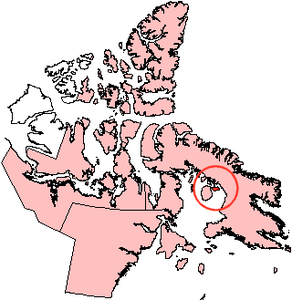Air Force Island
| Air Force Island | |
|---|---|
| NASA image of Prince Charles Island (center) and Air Force Island (to the right) | |
| Waters | Foxe Basin |
| Archipelago | Canadian Arctic Archipelago |
| Geographical location | 67 ° 58 ′ N , 74 ° 5 ′ W |
| length | 20 km |
| width | 62 km |
| surface | 1 612 km² |
| Highest elevation | 91 m |
| Residents | uninhabited |
Air Force Island is an uninhabited island in the Foxe Basin of 1,612 km² (for comparison: Rügen 926 km²) off the southwest coast of the much larger Baffin Island . It belongs to Nunavut Territory , Canada .
geography
The island, which resembles a lying oval, is around 62 km wide, 20 km long and has a circumference of 201 km. The Fee Peninsula stands out as an appendage on its north coast . Various information has been published on the land area: 1510 km² to 1720 km². The 11 km wide Cockram Strait separates Air Force Island from the larger Prince Charles Island to the west .
The island is very flat, with a maximum height of 91 meters. In the approximate center of the island there are some larger, scattered lakes and ponds.
climate
The climate of Air Force Island and the neighboring islands is heavily influenced by the water of the Foxe Basin, which is ice-covered for most of the year. The waters around the island are only navigable to a limited extent from the end of August to September. Temperatures above freezing point exist only in June, July and the first half of August, but it hardly gets warmer than 9 ° C. The snow only melts in the second half of July.
Flora and fauna
The landscape is characterized by salt marshes and low tundra vegetation, mainly sedges and other grasses , mosses and lichens grow .
An expedition by the Canadian Wildlife Service in 1996 and 1997 showed that the island is an important refuge and breeding area for numerous Arctic bird species. 42 different species have been identified, 25 of which breed on Air Force Island. There are extensive breeding areas, which are among the most important in the Canadian Arctic, in particular for the Thor's chickens ( Phalaropus fulicaria ) and the sandpiped sandpiper ( Calidris fuscicollis ). Therefore Air Force Island is designated as an Important Bird Area (NU011) by BirdLife International together with Prince Charles Island and Foley Island .
The mammals include: polar bears ( Ursus maritimus ), arctic foxes ( Alopex lagopus ) and lemmings ( Dicrostonyx torquatus ). Herds of caribou migrate from the surrounding islands, especially Baffin Island.
history
Most likely, the Inuit of Iglulik and Sanirajak already knew Air Force Island in historical times, but they didn't even bother to come up with a name for the island, as it was obviously of little importance for hunting.
Following the reconnaissance and measurement flights that began in World War II for military reasons, the Canadian military decided in 1946 to map large areas of the Canadian Arctic under the name "Operation Polaris". The flights could only take place in the short summer season. Avro Lancaster bombers were mainly used for vertical aerial photographs , which were upgraded so that they could remain in the air for 22 hours. In July 1948, a Lancaster of the 408 Squadron from Frobisher Bay flew over the Foxe Basin and discovered three unknown islands that were not shown on the previous maps. One of them was named Air Force Island in memory of the outstanding role the Royal Canadian Air Force played in exploring and developing the Canadian Arctic.
Individual evidence
- ^ A b UN System-Wide Earth Watch Web Site - Air Force
- ↑ The Atlas of Canada - Sea Islands ( Memento from January 22, 2013 in the Internet Archive ) (English)
- ^ WE Markham: Ice cover. Chapter 6 in IP Martini (ed.): Canadian inland seas , New York, 1986
- ↑ Victoria H. Johnston and Stephen T. Pepper: The Birds of Prince Charles Island and Air Force Island, Foxe Basin, Nunavut; Canadian Wildlife Service Occasional Paper Number 117, Quebec 2009
- ↑ Foxe Basin Islands on the IBA Canada website (English)
- ^ KJ Crowe: A cultural geography of northern Foxe Basin, Vancouver 1969
- ^ Hugh A. Halliday: Mapping In Full Flight: Air Force, Part 28, Canadian Military History in Perspective; in Legion of August 18, 2008
- ^ Derek Hayes: Three Arctic islands were the last large land masses discovered in North America; in Canadian Geographic September / October 2003

